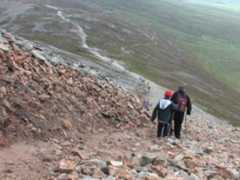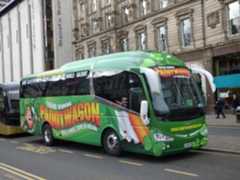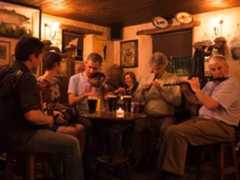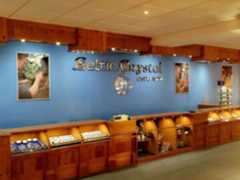
A history of St Patrick, patron saint of Ireland
St. Patrick’s Galway Connections, Facts, Feast Day & Death
Saint Patrick was a Christian missionary and bishop in Ireland. Known as the “Apostle of Ireland”, he is the primary patron saint of Ireland along with Saints Brigid and Columba.
The dates of Patrick’s life cannot be fixed with certainty but, on a widespread interpretation, he was active as a missionary in Ireland during the second half of the fifth century. He is generally credited with being the first bishop of Armagh.
It is said that he was about 16 years old he was captured from his home in Great Britain by Irish Pirates, and taken as a slave to Ireland, where he lived for six years before escaping and returning to his family. During his time in Ireland it is believed Patrick was a Shepard on the slopes of the Slemish Mountains in County Antrim. Ireland at this time was a land of Druids and pagans. When he arrived home he was re-united with his family and friends. He later began to realize that he may have a vocation to the priesthood, or some ministry of prayer in the Church. At this time the Church was already established somewhat in Ireland. There was already an Archbishop of Armagh by the name of Pallidus.
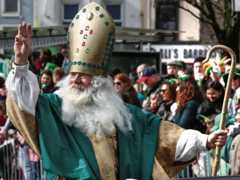
St. Patrick’s Day parade Galway
When Patrick was ordained a priest, he asked to be sent as a missionary to Ireland, back then it was known as Hibernia, which means the “Land of Winter.” Patrick was soon to become Ireland’s Archbishop of Armagh and Primate of all Ireland. This he undertook and gave himself two mandates, first to convert the pagan Irish to Christianity, and secondly to setting up the ecclesiastical structures and dioceses with a view to achieving independence from Arles, which was supporting the missionary activity in Ireland up until that time.
He travelled the length and breadth of the island of Ireland, baptising people and establishing monasteries, schools and churches as he went. It is believed that St Patrick used the shamrock which is the national flower of Ireland to explain the Holy Trinity to the pagans. It is also believed that he chased all the snakes out of Ireland by driving them into the sea; this of course is a myth. St Patrick is also the one who left us with the Celtic cross. When he began to evangelize he found that many of the pagans had worshipped the sun and so he embodied the sun into the Latin cross, likewise when he met the Druids who worshipped a sacred standing stone that was marked with a circle, which was symbolic of the moon goddess, which he embodied that also. The Celtic cross is now world famous and revered by all.
Saint Patrick’s Day in Galway and throughout Ireland takes place on the 17th of March, the date of his death. It is celebrated inside and outside Ireland as a religious and cultural holiday. Many big cities and small towns along with people around the world have a parade in his honour and wear green to represent Ireland and many buildings around the world turn green along with rivers and fountains.
It is not known for sure where his remains were laid although Downpatrick in County Down in the North of Ireland is thought to be his final resting place.
There are many different stories about St. Patrick and the events in his life but his memory lives on strong with the people of Ireland and around the world.
St Patrick’s connections to Galway
West of Galway City is the village of Killannin, a townland named after St Annin, a druidess during the time of St Patrick, is fabled to have potentially been his lover had he not been faithful to his vow of his celibacy due to his devout Christianity.
Inchigoill Island: A sacred place
A stronger connection stems from the ancient religious remains on Inchagoill Island, an island popular with visitor taking theCorrib Cruise from Cong andOughterard. The most noteworthy of these ancient artifacts conserved on Inchagoill Island is the Early Christian church of St Patrick, believed to have been built by Patrick and his nephew Lugna, who died on the island (circa 500 AD).

Church of St. Patrick, Inchigoill Island, Lough Corrib
The headstone of Lugna bears the inscription, “LIE LUGUAEDON MACCI MENUECH” which translates to “The Stone of Luguaedon Son Of Menuech”. This text is considered to be the oldest inscription in Roman letters in Europe other than found at the catacombs in Rome. Menuech is almost certain to have been a reference to Liamain, which was the name of St Patrick’s sister and Lugna is also reputed to have been St Patrick’s navigator. This monumental stone is a single, four sided pillar which is significantly in the shape of a boat’s rudder.
Mám Éan Chapel / Leaba Phádraig in Connemara
Maumean, also known as Mám Éan or ‘the pass of the birds,’ stands as one of the primary passes through the Maumturk mountain range, historically marking the boundary between Connemara proper and Joyce Country in Co. Galway. Legend has it that during his travels through the Maam Valley, Saint Patrick paused at Maumean on his journey back from Croagh Patrick in Co. Mayo. From the summit of the pass, he bestowed his blessing upon the land to the west – Connemara. That evening, he sought rest in a small hollow in the hillside, now known as Patrick’s Bed (Leaba Phádraic), before continuing his journey.

Mám Éan Chapel in the Maumturk Mountains of Connemara
Over time, Maumean evolved into a significant pilgrimage site, where locals gathered annually in August for a ‘pattern’ – a day of prayer and celebration in honor of Saint Patrick.
A short history of St. Patrick
Fun Facts about St Patrick… Patron Saint of Ireland ☘️
- St Patrick Died on March 17th
- At the age of 16 years old he kidnapped by Irish raiders and sold as a slave
- He was from Great Britain
- St. Patrick used the shamrock to preach about the holy trinity
- St Patrick’s Day is a massive day for brewers. An estimate amount spent on beer for Saint Patrick’s Day celebrations at €214 million
- Legend says St. Patrick drove all the snakes from Ireland
- The World’s Shortest St. Patrick’s Day Parade in Riverdale, in the Bronx, NY. The event took place on March 17, 2014 and raised $2,300 to help feed the homeless. It was a spectacular success
- The Shamrock is the national flower of Ireland but not the symbol. The harp is the national symbol
- Your odds of finding a four-leaf clover are About 1 in 10,000
- His colour was “Saint Patrick’s blue,” a light shade. The colour green only became associated with the St Patricks day after it was linked to the Irish independence movement in the late 18th century
- The St. Patrick‘s Day parade was invented in the United States
- Nine of the people who signed our Declaration of Independence were of Irish origin, and nineteen Presidents of the United States proudly claim Irish heritage — including our first President, George Washington
- St. Patrick’s Day has been celebrated in space – twice
- St Patrick’s Day was considered a strictly religious holiday in Ireland, which meant that the nation’s pubs were closed for business on the 17th of March. In 1970, the day was converted to a national holiday, and the stout and Beer resumed flowing.
- Chicago dyes its river green on St. Patrick’s Day
- In Seattle, there is a ceremony where a green stripe is painted down the roads
- 34 million Americans have Irish ancestry, according to the 2003 US Census. That’s almost nine times the population of Ireland
- Legend says that each leaf of the clover means something: the first is for hope, the second for faith, the third for love and the fourth for luck
You may also be interested in...
